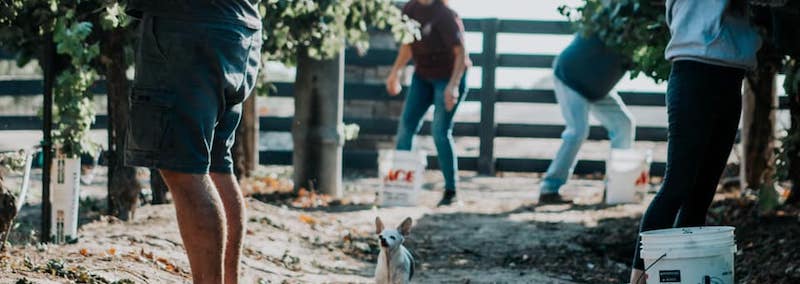I met my boyfriend in 2018, and our second date was to his hometown in Northern California- the definition of a small town in my books- where we shared our first kiss in some grapevines. That is probably too much information than you cared to know, except for me it was the beginning of learning all about producing wine on a small scale. From planting to bottling, and everything in between, the past couple of years of helping his family make wine has been a fun and educational experience I have come to love being a part of. Every year, they bottle hundreds of bottles of wine to give out to friends and family as holiday and special occasion gifts. This year we harvested roughly 1,200lbs of wine grapes.
Much like every crop or livestock life cycle, there are specific times in which certain things happen. For the small wine-grape vineyard, my boyfriend’s family owns, clusters (the formation of grapes on a vine) start appearing around April and grow until about September of each year when we harvest. Harvesting the wine grapes is largely dependent on the sugar level (brix) that the grapes are before being clipped. This is an important number, measured using the juice of picked grapes on a small hand-held device, because it largely affects the flavor of the wine. Brix amounts are different for each variety of grapes. When the wine grapes measure at the appropriate amount of brix, harvest begins!
The day of harvest is a little chaotic, but a lot of fun. Family and friends gather at the ranch and start helping wherever they are needed. We have people clipping wine grape clusters off the vines- a job not relatively easy to do since you’re literally up in the vines cutting them off. The clusters are then put into 5-gallon buckets.
Once the buckets are full, they are taken to be weighed and then dumped into the de-stemmer. The de-stemmer is a hand-cranked machine that is an efficient way to remove the rachis and peduncle (the stem part of the cluster) from the fruit and separates the grapes- obviously, having anything besides the grape juice and skins isn’t good for the fermenting process. The grapes fall into one bin, while the stems are dumped into another and then fed to the chickens and cattle.
To be extra certain that only the grapes are fully separated from the stems, the crushed fruit is placed into bins on a table where most of the people stand and help to separate anything left after the grapes are put through the de-stemmer. These bins are then dumped into a large tub in the “wine room” where they will spend approximately a week before being pressed.
Pressing the grapes is a lot of fun. We use a friend’s basket press in order to extract all the juice from the grape skins. The press requires a lot of manpower in order to get as much juice out as possible. We then store the juice in a couple of wine barrels and a steel tank for many months until they are ready for bottling. The leftover skins are called Pomace and is a nice little snack for the cattle (in small amounts of course).
Bottling happens in springtime, but that’s a whole other family gathering that I will share with you soon! It’s truly an amazing process, watching this small vineyard grow, and seeing the kind of yield we get, and being able to taste wine you helped to make is so rewarding. My boyfriend, his sister and, and their family do so much work to make this successful every year and I am thankful to be a part of it! Cheers to the 2020 vintage!







